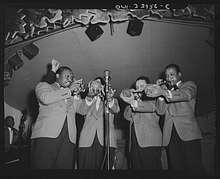Mainstream jazz
Mainstream jazz is the popular jazz music of an era. The term that was established in the 1950s by music journalist Stanley Dance, who considered anything within the popular jazz music of the Swing Era, "mainstream".[1] Another way to describe mainstream jazz in the 1950s was music that did not incorporate the bebop style.[1]

Jazz in the mainstream
After Dance defined mainstream jazz in the 1950s, the definition changed with the evolution and progression of jazz music. What was mainstream then would not be considered mainstream now. In a general sense, mainstream jazz can be considered what was most popular at the time: For example, during the Swing era, swing and big band music were in their prime and what target audiences were looking for. Although bebop was introduced into jazz during that time, audiences had not developed an ear for it.[1]
Mainstream jazz musicians
The jazz musicians listed below were either considered "mainstream" musicians, or were influenced by mainstream musicians.
Swing era
- Duke Ellington was an important influence on mainstream jazz; his music during the swing era was not known for breaking rules.[2]
- Coleman Hawkins made significant contributions to big band music prior to introducing bebop to his style.[3]
- Johnny Hodges was a member of Duke Ellington's Orchestra and became a familiar voice within the orchestra itself.[4]
- Benny Carter was a major influence on the big band style.
- Roy Eldridge has been named one of the most influential jazz musicians both within the swing era and to the development of bebop. His trumpet playing was influenced by Louis Armstrong.[5]
Mainstream jazz in popular culture
In the 1950s and 1960s, jazz was a mainstream part of pop culture. Jazz music was on the radio and Hollywood frequently incorporated jazz in television and films. It wasn't until artists like Elvis Presley and other Rock and roll influences became more prevalent that jazz became less popular.[6]
References
- McRae, Barry. 2005. "Sound Investment: Mainstream." Jazz Journal International, Aug 1, 10.
- Dance, Stanley. 1970. The World of Duke Ellington. New York: Scribner.
- Yanow, Scott. "Coleman Hawkins". All Music. Retrieved 11 December 2017.
- Tumpak, John R. (2011). "Johnny Hodges: Sensual Musical Beauty". Memory Lane (172): 41–42.
- Schuller, Gunther (11 December 2017). "Eldridge, (David) Roy ['Little Jazz']". Oxford Music Online.
- Stanbridge, Alan (2008-05-01). "From the Margins to the Mainstream: Jazz, Social Relations, and Discourses of Value". Critical Studies in Improvisation / Études critiques en improvisation. 4 (1). doi:10.21083/csieci.v4i1.361. ISSN 1712-0624.